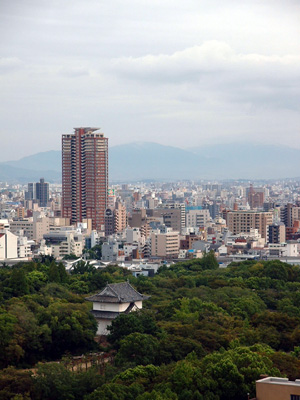Vernacular
Atmosphere
 Jessica Von Wendel
Jessica Von Wendel
I step
off the train and enter Osaka. I am standing in the midst of ten Japanese
students who are taking me around the city. They
speak English fairly well, and I already get the
impression of how
much Japan is like America. I hear English instead of Japanese, we are
dressed in the same type of clothes (although they are more
fashionable), and
we talk about the things that we both know, like television and movie
stars. However, we are very
different. They have retained Japanese
customs despite being modernized. The
city itself is the same. It contains
both transnational urbanism and vernacular architecture and history. Here is a cityscape of vast contrasts full of
international influence.
Japan
has been
able to preserve a very ancient history despite becoming one of the
most modern
nations in the world. The old and the
new are juxtaposed right next to each other. In
one photo I captured the skyscrapers of downtown Osaka with a
traditional temple building in
the midst of a forest in the foreground. Two
seemingly opposites, yet the vernacular temple and
transnational
urban city are almost complimentary to each other.
This
same traditional temple might be called vernacular when compared to a
skyscraper, but in comparison with its immediate surroundings it
actually
becomes the new transnational. Osaka castle was
burned
down and has been recently rebuilt adding an elevator and fresh paint. It lost its originality and is more of a high
tech museum enclosed within a shell of the ancient ideal.
Surrounding the castle are woods. As
we walked through them, I noticed large
blue tarps tied to trees. My friends
explained that this was one of the biggest tent cities for Osaka’s homeless. However, these were not simple tents; these
were two bedroom townhouses, complete with a covered cooking area. In social scientist, Takashi Makimura’s
article, "The Urban Restructuring Process in Tokyo in the 1980s:
Transforming Tokyo into a World City" he discusses sociospatial
transformations resulting
from
globalization that have influenced residential recomposition and
displacement. It is possible that these
homeless communities are the result of urban transnationalism that
pushed them
out of their old communities.
These
homeless constructions in the middle of a forest at the base of a
castle became
the
vernacular; old and recycled to shelter the inhabitants from the
elements, but
more real than a new make-believe, urbanized, fortress.
At
another temple in Kyoto,
the atmosphere was ancient and mystical. Religious
rituals were being performed, incense was
burning and the
structure itself invoked a sense of awe. I
looked to my left and ten feet away sat a souvenir stand
and the
atmosphere faded. All the way up the
hill were little shops selling everything from good luck charms, bowls,
Buddha
statues, fortunes, and decorative chopsticks. How
had the introduction of these little shops affected
the overall
meaning of making a visit to this sacred site?
Buddhism itself preaches against desire and materialism
yet here were
shops making money selling trinkets to visitors.
Everywhere
in Japan
I saw the vernacular and the transnational intermingled.
In America
we say that we are a
completely modernized nation. In Japan
the
process is still under way. The remains
of the past are still tucked away trying to hold on as new cities sweep
in and
business booms. Most assume that
modernization
is an inevitable end to progress. While
the vernacular temples are protected as heritage sites, that doesn’t
stop their
impact from being lost in the transition.
|

 Jessica Von Wendel
Jessica Von Wendel